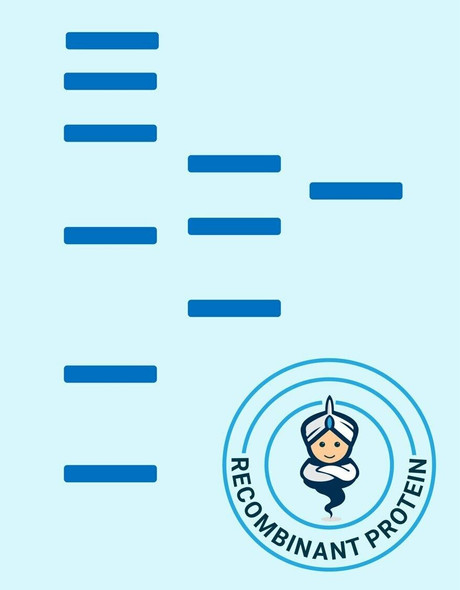Human CST3 Recombinant Protein (RPPB3282)
- SKU:
- RPPB3282
- Product type:
- Recombinant Protein
- Size:
- 10ug
- Species:
- Human
- Target:
- CST3
- Synonyms:
- Cystatin-C
- Cystatin-3
- Neuroendocrine basic polypeptide
- Gamma-trace
- Source:
- Escherichia Coli
- Uniprot:
- P01034
Description
| Product Name: | Human CST3 Recombinant Protein |
| Product Code: | RPPB3282 |
| Size: | 10µg |
| Species: | Human |
| Target: | CST3 |
| Synonyms: | Cystatin-C, Cystatin-3, Neuroendocrine basic polypeptide, Gamma-trace, Post-gamma-globulin, CST3, MGC117328. |
| Source: | Escherichia Coli |
| Physical Appearance: | Sterile Filtered colorless solution. |
| Formulation: | The CST3 solution (0.25mg/1ml) contains 0.1M NaCl, 20mM Tris-HCl buffer (pH 8.0) and 20% glycerol. |
| Stability: | Store at 4°C if entire vial will be used within 2-4 weeks. Store, frozen at -20°C for longer periods of time. For long term storage it is recommended to add a carrier protein (0.1% HSA or BSA).Avoid multiple freeze-thaw cycles. |
| Purity: | Greater than 95.0% as determined by SDS-PAGE. |
| Amino Acid Sequence: | MGSSHHHHHH SSGLVPRGSH MSSPGKPPRL VGGPMDASVE EEGVRRALDF AVGEYNKASN DMYHSRALQV VRARKQIVAG VNYFLDVELG RTTCTKTQPN LDNCPFHDQP HLKRKAFCSF QIYAVPWQGT MTLSKSTCQD A |
| Biological Activity: | The IC50 value is < 2.0nM. The inhibitory function of Cystatin 3 on protease activity of papain was measured by a fluorometric assay using Z-FR-AMC at pH 7.5 at 25?C. |
Cystatin C is part to the cystatin protein family, which has members with various cystatin-like sequences. Part of the proteins has the ability to act as active cysteine protease inhibitors, other members has lost or never had the ability. Three sub members of the cystatin protein family are the type 1 cystatins, type 2 cystatins & kininogens. The locus in chromosome twenty holds the most type 2 cystatin genes. Cystatin C can be found in the cystatin locus, it is the most common extracellular inhibitor of cysteine proteases, that is available in big volumes in biological fluids and exist in every tissue in the body.
CST3 Human Recombinant produced in E.Coli is a single, non-glycosylated polypeptide chain containing 141 amino acids (27-146 a.a.) and having a molecular mass of 15.6kDa.CST3 is fused to a 21 amino acid His tag at N-Terminus and purified by proprietary chromatographic techniques.
| UniProt Protein Function: | CST3: As an inhibitor of cysteine proteinases, this protein is thought to serve an important physiological role as a local regulator of this enzyme activity. Defects in CST3 are the cause of amyloidosis type 6 (AMYL6); also known as hereditary cerebral hemorrhage with amyloidosis (HCHWA), cerebral amyloid angiopathy (CAA) or cerebroarterial amyloidosis Icelandic type. AMYL6 is a hereditary generalized amyloidosis due to cystatin C amyloid deposition. Cystatin C amyloid accumulates in the walls of arteries, arterioles, and sometimes capillaries and veins of the brain, and in various organs including lymphoid tissue, spleen, salivary glands, and seminal vesicles. Amyloid deposition in the cerebral vessels results in cerebral amyloid angiopathy, cerebral hemorrhage and premature stroke. Cystatin C levels in the cerebrospinal fluid are abnormally low. Genetic variations in CST3 are associated with age- related macular degeneration type 11 (ARMD11). ARMD is a multifactorial eye disease and the most common cause of irreversible vision loss in the developed world. In most patients, the disease is manifest as ophthalmoscopically visible yellowish accumulations of protein and lipid that lie beneath the retinal pigment epithelium and within an elastin-containing structure known as Bruch membrane. Belongs to the cystatin family. |
| UniProt Protein Details: | Protein type:Secreted, signal peptide; Inhibitor; Secreted Chromosomal Location of Human Ortholog: 20p11.21 Cellular Component: extracellular space; extracellular region Molecular Function:protein binding; protease binding; beta-amyloid binding; endopeptidase inhibitor activity; cysteine protease inhibitor activity Biological Process: negative regulation of proteolysis; fibril organization and biogenesis; negative regulation of peptidase activity; defense response; regulation of tissue remodeling Disease: Macular Degeneration, Age-related, 11; Cerebral Amyloid Angiopathy, Cst3-related |
| NCBI Summary: | The cystatin superfamily encompasses proteins that contain multiple cystatin-like sequences. Some of the members are active cysteine protease inhibitors, while others have lost or perhaps never acquired this inhibitory activity. There are three inhibitory families in the superfamily, including the type 1 cystatins (stefins), type 2 cystatins and the kininogens. The type 2 cystatin proteins are a class of cysteine proteinase inhibitors found in a variety of human fluids and secretions, where they appear to provide protective functions. The cystatin locus on chromosome 20 contains the majority of the type 2 cystatin genes and pseudogenes. This gene is located in the cystatin locus and encodes the most abundant extracellular inhibitor of cysteine proteases, which is found in high concentrations in biological fluids and is expressed in virtually all organs of the body. A mutation in this gene has been associated with amyloid angiopathy. Expression of this protein in vascular wall smooth muscle cells is severely reduced in both atherosclerotic and aneurysmal aortic lesions, establishing its role in vascular disease. In addition, this protein has been shown to have an antimicrobial function, inhibiting the replication of herpes simplex virus. Alternative splicing results in multiple transcript variants encoding a single protein. [provided by RefSeq, Nov 2014] |
| UniProt Code: | P01034 |
| NCBI GenInfo Identifier: | 118183 |
| NCBI Gene ID: | 1471 |
| NCBI Accession: | P01034.1 |
| UniProt Related Accession: | P01034 |
| Molecular Weight: | |
| NCBI Full Name: | Cystatin-C |
| NCBI Synonym Full Names: | cystatin C |
| NCBI Official Symbol: | CST3 |
| NCBI Official Synonym Symbols: | ARMD11; HEL-S-2 |
| NCBI Protein Information: | cystatin-C |
| UniProt Protein Name: | Cystatin-C |
| UniProt Synonym Protein Names: | Cystatin-3; Gamma-trace; Neuroendocrine basic polypeptide; Post-gamma-globulin |
| Protein Family: | Cystatin |
| UniProt Gene Name: | CST3 |
| UniProt Entry Name: | CYTC_HUMAN |










